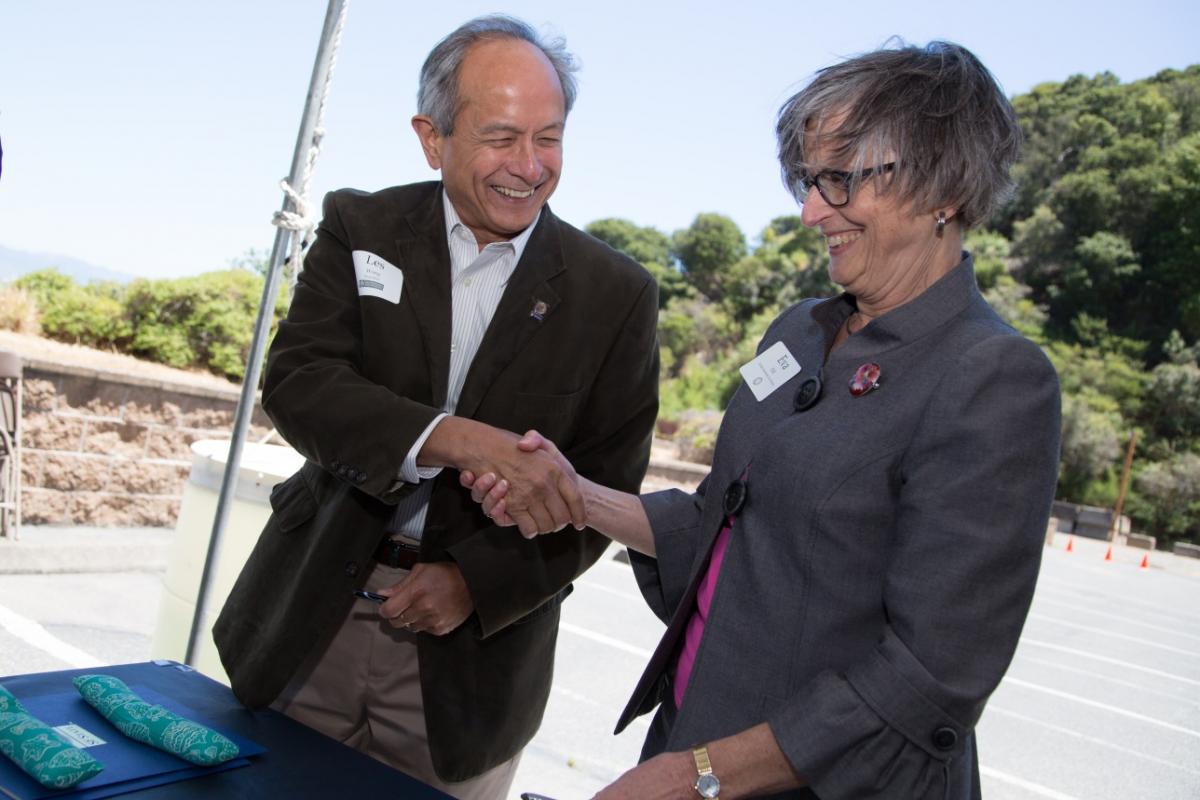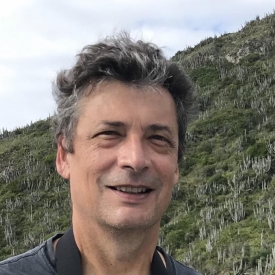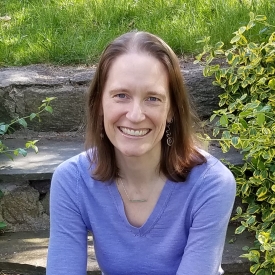On June 8, 2013, leaders from the Smithsonian Institution and San Francisco State University (parent organizations to the Smithsonian Environmental Research Center and the Rhomberg Tiburon Center), met to profile this research and also and to sign a formal Memorandum of Understanding (MOU) that aims to expand the scope of the partnership to advance research and education activities across a diverse range of topics in marine science.
The Smithsonian Environmental Research Center’s (SERC) Marine Invasions Research Laboratory has maintained one of its core research laboratories on San Francisco Bay for 13 years, located at the Romberg Tiburon Center (RTC) --- a vibrant marine research and teaching facility of San Francisco State University. In this time, visiting researchers and students from around the globe have worked alongside resident SERC and RTC scientists of to advance our understanding of marine invasions in California waters. We’ve conducted long-term research on patterns of invasions in space and time, using field-based surveys and mining the historical record to examine changes in marine invertebrate communities (species composition and abundance). We have also focused intensively on understanding transfer mechanisms (or vectors) for non-native species, with extensive analyses of biota associated with vessels’ hulls and ballast water.
To date, SERC’s research in San Francisco Bay has examined the basic science of invasions and also management strategies to reduce the likelihood of future invasions and undesired impacts. The latter includes research on the feasibility of eradication and control of invasive species in California, using model species such as the European Green Crab Carcinus maenas, periwinkles Littorina littorea and L. saxatilis, the Asian Kelp Undaria pinnatifida, the Japanese Mudsnail Batillaria attramentaria, the colonial tunicate Didemnum vexillum, and the Knotted Kelp Ascophyllum nodosum. The research effort for the Asian Kelp, the European Green Crab, and the Japanese Mudsnail has benefited from talented volunteer scientists anxious to explore various strategies for eradication and control. Detailed information about these projects and more can be found on our website.

Formalizing the partnership between the Smithsonian Institution and San Francisco State University – what does this mean for future research?
Leslie E. Wong, President of San Francisco State University with Eva J. Pell, Under Secretary For Science at the Smithsonian Institution after signing the Memorandum of Understanding.
The new MOU between the Smithsonian and San Francisco State University seeks to establish a broad base of marine research between the two organizations, and create a catalyst for more expansive collaboration with other regional partners, to understand the biological structure and function of coastal ecosystems. It will also create new opportunities for student training and public engagement, including Participatory Science. Major goals of the MOU are to (a) advance RTC as a key regional site for long-term, multi-disciplinary marine research and (b) establish RTC as a core site and member of the Tennenbaum Marine Observatory Network (TMON).
What is the Tennenbaum Marine Observatory Network?
The Smithsonian Institution has established the Tennenbaum Marine Observatory Network (with associated MarineGEO sites) to provide a coordinated framework for marine coastal ecosystem research around the world. TMON research focuses on marine biodiversity, from the population to the ecosystem level, harnessing the power of a global network to understand and sustain key ecological processes and functions in marine ecosystems.

The health of marine systems is changing rapidly – they are being overfished, impacted by invasive species, and polluted. Add to that the changes coming through climate change – increases in atmospheric carbon dioxide, sea level rise, warming, and acidification – and the health of some systems is reaching critical. A key challenge is to understand these drivers of change and to evaluate options to sustain biodiversity, function, and key resources.
While scientists are working around the world to understand the risks facing our oceans, the Tennenbaum Marine Observatory Network will link these separate efforts providing standardized, repeated, long-term measurements and innovative experiments that are comparable across that entire network. This rigorous approach is designed explicitly for comparisons among sites to understand environmental and ecological changes at both local and global scales. The network is here for the long-term, and we expect sustained core measures across the network for the next 30 to 50 years.
In addition to world-class research, the network will also provide a platform for educational and outreach activities for students, volunteer scientists, resource managers, and policy-makers. One of the central questions being explored is how local-to-regional human activities, such as fishing and land use, affect our marine ecosystems? Such questions cannot be properly addressed, nor creative solutions implemented, without the involvement and cooperation of a diverse group of citizens, managers, and researchers. Knowledge is most powerful when shared within the entire community.
The research being conducted by the SERC’s Marine Invasions Lab will be one of many directions pursued by the Tennenbaum Marine Observatory Network. As the Director of the Smithsonian Environmental Research Center, Dr. Anson H. Hines, explains:
“The new agreement seeks to expand the Tennenbaum Marine Observatory Network from Smithsonian sites along the Atlantic Coast to establish RTC as a hub for a Marine Global Earth Observatory in San Francisco Bay. The new MOU advances SERC and RTC collaborations in key additional areas for the Observatory, including sea grass ecosystems, salt marsh conservation and restoration, climate change, estuarine ecology, fisheries, and toxic chemicals. These are important areas supporting science-based policy and management. The new initiative also envisions opportunities for training of undergraduate and graduate students, and for public education and outreach. All of this is in your backyard in Marin County and the San Francisco Bay area."
 |
 |
|
Resident SERC staff Lina Ceballos (left) and Linda McCann (right) displaying and discussing local marine life with visitors during the June 8, 2013 event. Photos courtesy of Robin Gibbin of SERC. |
|



